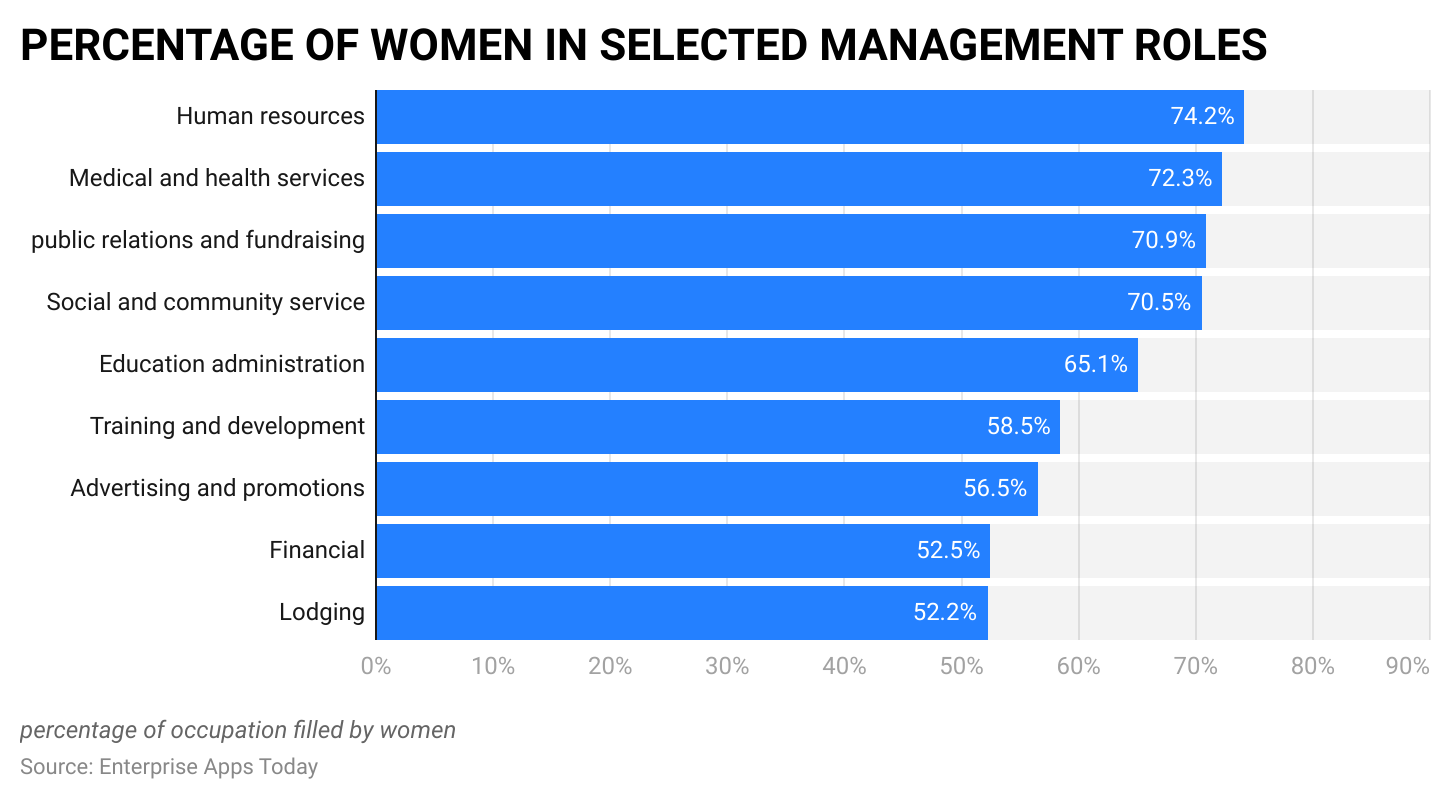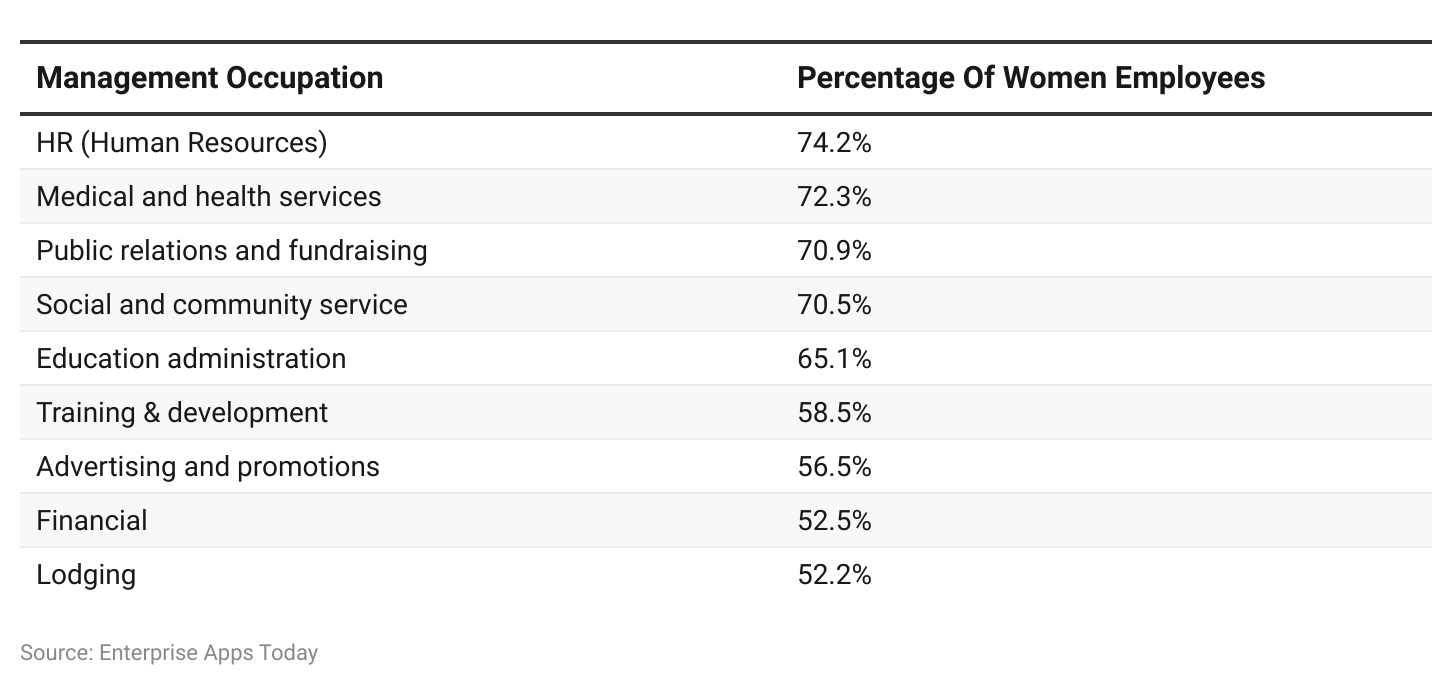30+ Surprising Leadership Statistics 2023: Important Things That All Leaders Should Know About Leadership

Page Contents [hide]
- Amazing Leadership Statistics (Editor’s Choice)
- Leadership Statistics by world leader in science and technology by 2030
- General Leadership Statistics
- Leadership and Gender Statistics
- Leadership and Race Statistics
- Leadership and Age Statistics
- Leadership Training Statistics
- Challenges For Leadership Statistics
- Leadership & Corporate Culture Statistics
- Leadership Skills Statistics
- Conclusion
Leadership Statistics: As the market changes, the needs of businesses change as well. The company culture has always included leadership, but that culture is evolving.
Great leaders should be able to drive a business to success, increase team productivity, and build a unique work culture. In this article, we will discuss leadership facts and stats.
Let's get into some of the most recent leadership statistics.
Amazing Leadership Statistics (Editor’s Choice)
- Only 33% say they feel engaged.
- 69% of employees stated that they would be willing to work harder if their efforts were appreciated more.
- 77% of businesses feel their leadership is inept.
- Only 20% of CEO posts are held by women.
- Only 8.2% of Fortune 500 companies are led by women.
- Female HR managers make up 72% of all managerial positions.
- Only 5% of companies have implemented leadership development at all levels. However, 83% believe that it is essential to develop leaders at all levels of an organization.
- Only 48% of employees think their company's leadership is of “excellent quality”.
- A lack of appreciation is the reason 79% of workers quit their jobs.
- Only 10% are natural leaders. The remaining 20% have basic management skills that can be developed into high-quality leadership.
- 78% of leaders in corporations are active and often focused on engaging their employees.
- The US spends $166 billion annually on leadership development, which is approximately $366 billion worldwide.
- The top three skills demanded of every leader are empathy (17%), humility (15%), and self-awareness (7%).
- According to Leadership Statistics, by 2024 the global corporate leadership market is projected to reach $26. Billion.
- 35% of the employees in the United States of America prioritize leadership.
- Due to leadership, 63% of the companies in the United States of America experience retention problems.
- According to Leadership Statistics, 10% of the CEOs are natural leaders and lead by example.
- 78% of leaders regularly engage with their employees.
- According to 77% of the companies, they lack leadership skills.
- Internal hiring for leadership positions is 25% more likely to proceed as compared to external hiring.
Leadership Statistics by world leader in science and technology by 2030
 (Source: statista.com)
(Source: statista.com)
By 2030, according to studies by some US adults, the United States of America is expected to be a world leader with great skills in science and technology as said by more than 50% of the people.
General Leadership Statistics
#1. Only 33% of workers say they feel engaged.
Employee engagement is significant to a company's success, yet few workers believe that their leadership is encouraging them in a way that increases their engagement.
#2. 69% of employees said they would work harder if they thought their efforts were better appreciated.
Employees who feel appreciated and their work is recognized are more committed and can assist the company in achieving its objectives. Management and other organizational leaders are responsible for identifying and rewarding personnel.
#3. 77% of businesses say that their leadership is inadequate.
Everyone understands the importance of having excellent leadership at every level of a company, but businesses often struggle to identify and develop leaders.
#4. Employers who are engaged with their employees are 22% more profitable.
This statistic should motivate all executives to promote engagement and take the required steps to ascertain what would make their workforce job more fruitful.
Leadership and Gender Statistics
 (Source: teamstage.io)
(Source: teamstage.io)
As of today, 38% of the companies have female senior managers, the majority of them located in the African region, followed by Eastern Europe (35%) and Latin America (33%). With some growing leadership female skills, Asia Pacific has ranked lowest having 27% of the share.
#5. Women hold only 20% of CEO positions.
However, just 20% of CEO roles are held by women, despite the fact that women make up roughly 40% of business managers. This difference shows that women are less likely to be promoted to the top leadership positions inside a company.
#6. Among the Fortune 500, just 8.2% of companies are run by women.
In 2021, Fortune Magazine stated that women were in charge of 41 of the top 500 firms. This is only 8.2%. Black women hold two of those roles, which are considered a move in the right direction for workplace diversity but still put them well behind their male counterparts in terms of leadership opportunities.
While it seems like women are making progress in the workforce and are more represented in management roles, there is still evidence of a glass ceiling because few of them reach the highest employment levels. Although there is some forward momentum, it is slow.
(Source: Zippia)
#7. Women held only 18% of managerial jobs in 1972. Nearly 40% of all managers in 2016 were female.
When it comes to holding leadership roles in the workforce, women now seem to be more represented than they did in the past.
#8. 74.2% of HR managers are female, the highest rate of all management positions.
While fewer leadership positions are available for women, they make up a more significant percentage of the workforce in specific sectors. Some examples include public relations, medical services, social services, and education.

(Source: Zippia)
Percentage Of Females In Management Positions By Management Occupation 2016
Leadership and Race Statistics
#9. According to the pay scale's breakdown by race & gender, Executive men from the Pacific Islands make the greatest money, while American Indian women make the least.
Gender and race breakdowns at the executive level have some astonishing insights, with women consistently performing lower than males and Hispanic and black men serving worse than men of other races. Strangely, Asian and Pacific Islander men make the most significant money but are not well represented in the workforce.
When you shift the stats to look at Manager/Supervisory-level positions, while still using the income of white males as the baseline, you see that Asian women and men make more money, with all other categories below white men's salaries.
#10. Following is a breakdown of the 1,122 persons who work in Legislative Bodies and Public Administration Executive Office.

It is not surprising that minorities of other races make up a smaller percentage of top positions and managerial positions in the workforce than their white colleagues, according to this BLS data.
#11. In Fortune 500 firms, as of June 2021, there are just four black CEOs.
The only companies that now have black CEOs are Lowes, Starbucks, TIAA-CREF, and Merck. Black women hold this position at TIAA-CREF and Starbucks.
#12. There have only been 19 black chief executive officers (CEOs) since the Fortune 500 list was first created in 1955.
There is a definite underrepresentation when it comes to black persons holding the highest positions in Fortune 500 businesses. Not many black people are given management opportunities early in their careers could be one factor contributing to this lack of diversity.
Leadership and Age Statistics
#13. The average age of the chief executive officer at the time of hiring is 54.1 years, and the age of business leaders in CFO and CEO roles is rising.
The average age of CFOs and CEOs was in the mid-40s in 2005. This has increased over the years, and CEOs now average in their mid-50s while Chief Financial Officers (CFOs) are more likely to be in their 40s.
(Source: Zippia)
Looking at the top leadership roles shows that education is vital to the individual looking for a leadership position in a company all over the world. 97% of CEOs have a Bachelor's degree, 64% of CEOs have a Master's degree or the equivalent (including MBAs), and 10% of chief executive officers have a Doctorate degree.
Education and age continue to be important factors in corporate leadership positions within companies. Both these stats are parallel because it takes time to get advanced degrees and progress to higher-level roles in organizations, resulting in an older leadership pool.

(Source: Zippia)
Leadership Training Statistics
#15. The majority of learning organizations (almost 95%) plan to raise or maintain their present level of investment in leadership development.
This is due to the fact that educational organizations make a lot of money from leadership development. It is a $366 billion industry worldwide, $166 billion of which is spent in the US alone.
#16. A lack of leadership development is perceived by 69% of millennials.
Millennials (people born between 1980-2000) are deeply ensconced within the workforce. Gen Xers and baby boomers are leaving more frequently, which means that companies are increasingly focusing on the needs of millennials. Companies must act quickly to address issues this age group has with leadership.
#17. Every year, a business delays leadership development, which represents 7% of its total annual sales.
In a corporation, leadership development is essential in many ways. By delaying development and not giving executives a chance to progress and grow, the firm reduces its profits by 7%.
#18. 83% of companies believe leadership development is vital at every level.
At a cognitive level, HR and Business leaders recognize that developing leaders inside the organization is better for its financial health and makes it more robust.
#19. 79% of workers leave their jobs due to a lack of appreciation.
Leadership's failure to adequately express appreciation to their workforce might result in profound disengagement that could result in the early departure of a worker. Leaders need to learn how to support their team members better.
#20. Only 5% of companies have implemented leadership development at every level in their businesses.
This stat is consistent with what millennials report. They noted that leadership was not developed and that this oversight had severe implications for businesses.
Challenges For Leadership Statistics
#21. Burnout is recognized as an illness by the World Health Organization and is categorized as an occupational phenomenon.
The IDC-11 code describes burnout as a syndrome that results from chronic workplace stress that has not been managed successfully. Interestingly, this description seems to imply that there is a strategy for effectively managing work-related stress.
#22. Healthcare costs at high-pressure organizations are roughly 50% higher than in other companies.
Most stressful jobs cost employers and employees more than they realize when you consider health care expenditures and the toll on the people involved.
#23. Stress is responsible for 60 to 80% of workplace accidents.
Employees who work in stressful environments suffer greatly, not only from mental health problems and stress-related illnesses but also from workplace accidents.
#24. Workplace stress accounts for up to 8% of national healthcare spending and 120,000 deaths annually.
Stress at the workplace is now a well-known condition that has nearly epidemic proportions in the United States and around the world. More solutions are required, and businesses must find methods to implement them in order to protect their employees, their bottom line, as well as the economy.
#25. According to the American Psychological Association, over $500 billion is siphoned off from the United States economy by occupational stress.
According to this statistic, occupational stress in the United States is approaching a crisis and costing the country billions of dollars. In addition, it prevents businesses from achieving potential success and facing more stress-related injuries and illnesses in the American population.
Leadership & Corporate Culture Statistics
#26. Employee disengagement was associated with a 37% increase in absenteeism, a 49% increase in accidents, and a 60% increase in workplace mistakes.
Companies realize that a disengaged workforce is more costly than they typically think. Increasing engagement and having the correct management team in place help businesses achieve their goals.
#27. Only 13% of workers around the world say they are actively involved in their occupations, while in the US, nearly 32% of workers say they are engaged in their jobs.
This low level of involvement indicates that many people are unsatisfied with their professional choices.
#28. 35% of employees in the United States put company culture at the top of their list when searching for work.
One-third of employees would reject the perfect job if the culture fit wasn't present. This shows the importance of a great work environment and good leadership.
#29. One in two people (50%) said they left their job at some point to escape a bad boss.
Many individuals report that they have experienced a bad boss. It raises the intriguing question of how many workers a terrible manager can ultimately fire throughout their tenure.
Leadership Skills Statistics
#30. The following are the top five skills of great leaders:
- Team development
- Civic-mindedness and ethical practice
- Self-development
- Innovation
- Team development
Having these leadership skills might give you a competitive edge when applying for management or top-level positions. Additionally, these skills are also crucial for people who work in leadership positions.
#31. 80% of workers are happy with their boss.
According to this statistic, leadership in the United States seems to be doing a great job, and workers are satisfied with their jobs.
Conclusion
It is obvious that outstanding leadership is crucial for businesses in various ways, from retaining good workers to encouraging them to put in more effort and increasing profits. It is also clear that lousy leadership can also be very harmful to a company and can contribute to health issues across the globe and can really contribute to health issues around the world, increasing healthcare costs.
Businesses must invest in leadership development programs to develop better leaders who can adapt to their constantly changing workforce.
Worldwide, there is a sizable market for developing leaders and their leadership abilities. Still, few organizations indicate that they are making the necessary efforts or giving leadership the attention it deserves.
Some important leadership statistics supporting the fact that companies constantly change with the times and adapt to leadership trends are the highly disproportionate number of women and minorities in top leadership and management roles within companies.
Although it seems like things are moving in the right direction, each generation can only hope to experience slight improvements in their work-life balance because the change is so sluggish and barely noticeable.
Focusing on leadership and early training for women and minorities would not only improve the upper-level diversity of businesses but also increase employee engagement and boost profits and the company's reputation.
Sources
FAQ.
Unfortunately, business generally takes a long time to accept women and minorities in top leadership roles. There seems to be some positive progress in this area, but it seems to be happening very slowly.
Lack of leadership development at the early stages of their careers and a lack of business support for the progress of women and minorities in the workforce are two contributing factors to the issue.
Learning institutions see a lot of potential in the leadership training market and are working to expand their offerings. Unfortunately, just 5% of companies have fully integrated leadership development. This indicates that businesses do not readily provide leadership training to their staff.
Training at the majority of educational institutions is available for those interested in becoming a leader, reaching higher levels of professionalism, getting higher levels in professional, and working in management. Self-education and self-training can assist you in gaining access to opportunities.
Good leaders motivate their staff to put forth more effort, which boosts productivity and increases revenues. On the other hand, bad leaders can cause stress that results in workplace accidents and severe health issues for workers.
Companies can significantly boost their performance and employee health by focusing on excellent management and developing strong team leadership skills.
Bad leadership is defined by inconsistency, narrow-mindedness, and poor communicative skills. Bad leaders will not listen to others' new ideas that challenge their way of thinking and fail to communicate a broader plan that includes a clear role for everyone. They also won't recognize and celebrate the accomplishments of their teams and individuals.
Truly poor leaders will blame others for their errors and actively resist natural tides of change from the lower ranks of their organization. The worst thing about bad leaders is their inability to understand the perspectives of those they want to lead.
Yes, everyone has the potential to lead. While specific personality traits and interpersonal styles will be more suited to leadership roles, few leadership skills can still be practiced and learned.
To be a trustworthy and authoritative leader, you can practice being a better listener, coach, resolver of conflict, and influencer.
A leader's mindset can be cultivated by focusing on business, long-term goals, and strategic thinking.
Leadership skills are highly industry-specific and dependent on the role. Because every leadership position will require its own set of skills and industry knowledge, more than anything, leaders must be professionals with the skills to inspire others and express a vision.
10% of the people are natural leaders. A further 20% of the population has enough leadership abilities to become great leaders with guidance, training, and support.
This Gallup study only focused on management and corporate leadership. This is a good proxy for leadership, but there are differences between corporate, political, sports, and other leaders. As a result, the rate of natural leadership varies depending on the situation.

Barry is a lover of everything technology. Figuring out how the software works and creating content to shed more light on the value it offers users is his favorite pastime. When not evaluating apps or programs, he's busy trying out new healthy recipes, doing yoga, meditating, or taking nature walks with his little one.



